Climate Change and Its Implications on Global and Local Healthcare
VerifiedAdded on 2021/05/31
|8
|2005
|50
Report
AI Summary
This report investigates the significant implications of climate change on both global and local healthcare systems. It begins by defining climate change and its causes, highlighting the impact of human activities such as fossil fuel burning and deforestation. The report then explores various health issues directly linked to climate change, including extreme temperatures, vector-borne diseases, and water-related illnesses. It analyzes the effects on food production, air quality, and community safety, particularly in areas like Bundoora, Victoria, Australia, and the rising costs of addressing catastrophic events. Recommendations include implementing policies for insurance and public health, protecting natural ecosystems, and adopting sustainable practices. The report emphasizes the need for reduced consumption, renewable energy sources, and stronger air quality controls to mitigate climate change impacts and adapt to changing conditions. It stresses the importance of adequately resourced healthcare systems to address these health challenges and the need to consider broader effects on housing, essential services, and the economy to ensure the well-being of all community members.
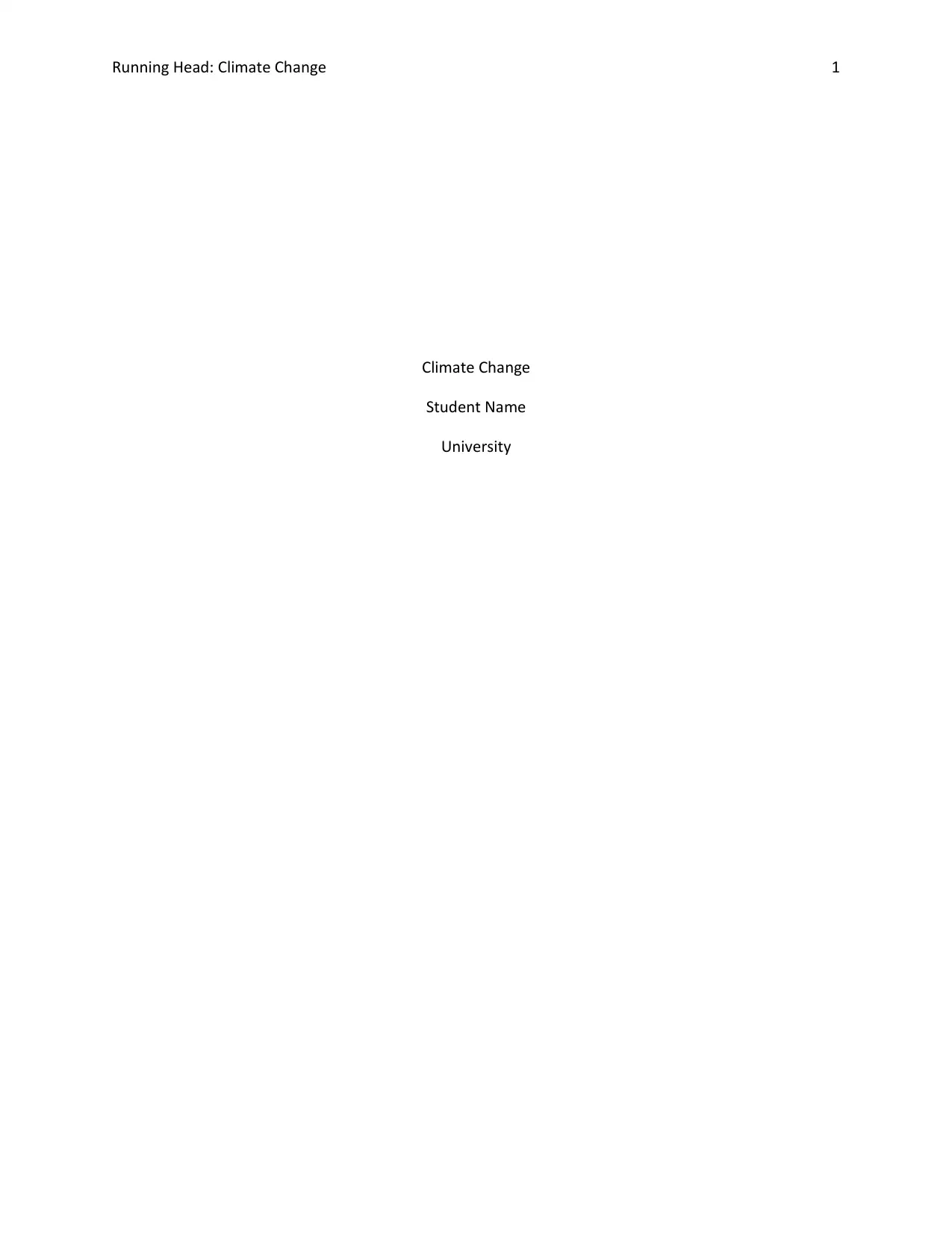
Running Head: Climate Change 1
Climate Change
Student Name
University
Climate Change
Student Name
University
Paraphrase This Document
Need a fresh take? Get an instant paraphrase of this document with our AI Paraphraser
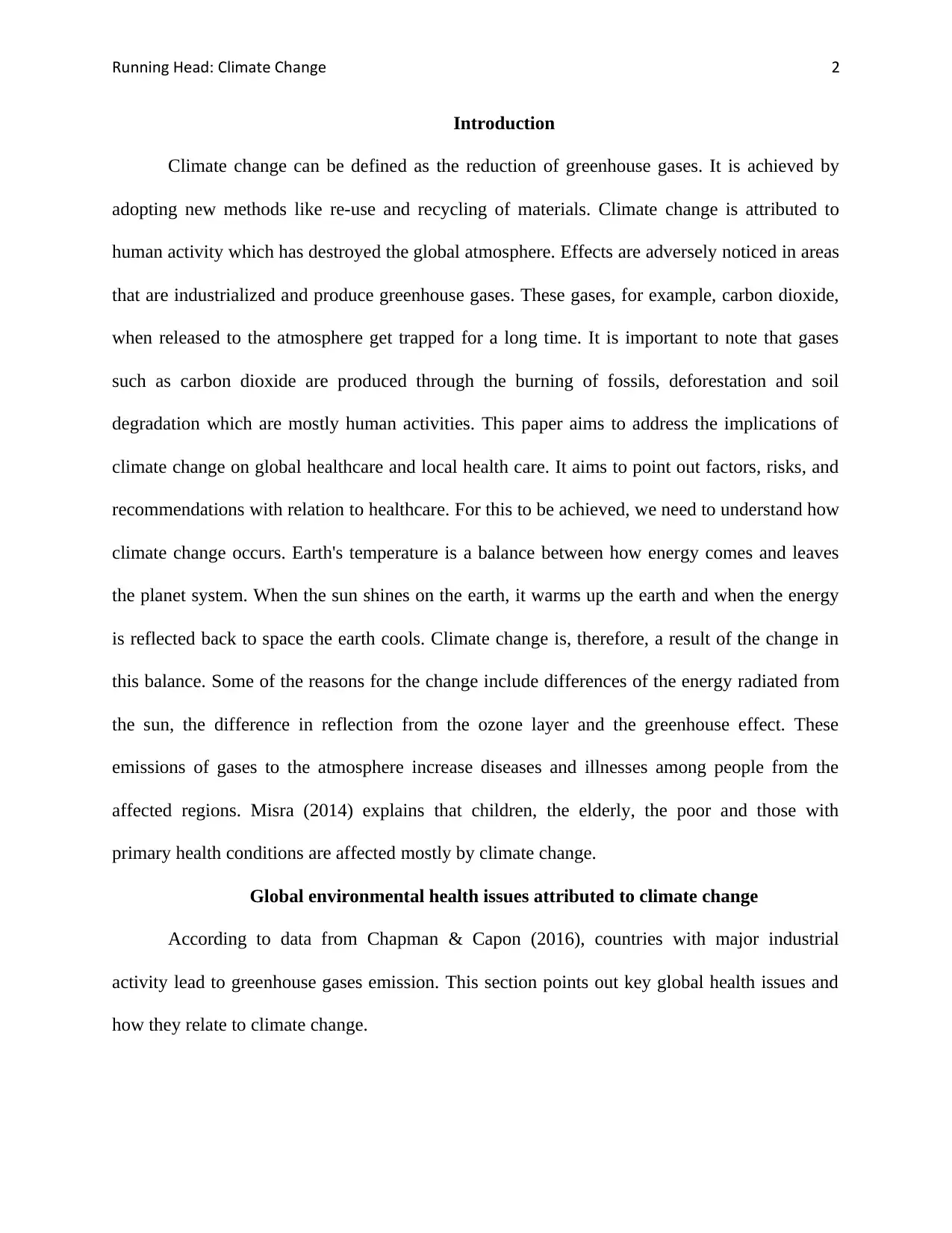
Running Head: Climate Change 2
Introduction
Climate change can be defined as the reduction of greenhouse gases. It is achieved by
adopting new methods like re-use and recycling of materials. Climate change is attributed to
human activity which has destroyed the global atmosphere. Effects are adversely noticed in areas
that are industrialized and produce greenhouse gases. These gases, for example, carbon dioxide,
when released to the atmosphere get trapped for a long time. It is important to note that gases
such as carbon dioxide are produced through the burning of fossils, deforestation and soil
degradation which are mostly human activities. This paper aims to address the implications of
climate change on global healthcare and local health care. It aims to point out factors, risks, and
recommendations with relation to healthcare. For this to be achieved, we need to understand how
climate change occurs. Earth's temperature is a balance between how energy comes and leaves
the planet system. When the sun shines on the earth, it warms up the earth and when the energy
is reflected back to space the earth cools. Climate change is, therefore, a result of the change in
this balance. Some of the reasons for the change include differences of the energy radiated from
the sun, the difference in reflection from the ozone layer and the greenhouse effect. These
emissions of gases to the atmosphere increase diseases and illnesses among people from the
affected regions. Misra (2014) explains that children, the elderly, the poor and those with
primary health conditions are affected mostly by climate change.
Global environmental health issues attributed to climate change
According to data from Chapman & Capon (2016), countries with major industrial
activity lead to greenhouse gases emission. This section points out key global health issues and
how they relate to climate change.
Introduction
Climate change can be defined as the reduction of greenhouse gases. It is achieved by
adopting new methods like re-use and recycling of materials. Climate change is attributed to
human activity which has destroyed the global atmosphere. Effects are adversely noticed in areas
that are industrialized and produce greenhouse gases. These gases, for example, carbon dioxide,
when released to the atmosphere get trapped for a long time. It is important to note that gases
such as carbon dioxide are produced through the burning of fossils, deforestation and soil
degradation which are mostly human activities. This paper aims to address the implications of
climate change on global healthcare and local health care. It aims to point out factors, risks, and
recommendations with relation to healthcare. For this to be achieved, we need to understand how
climate change occurs. Earth's temperature is a balance between how energy comes and leaves
the planet system. When the sun shines on the earth, it warms up the earth and when the energy
is reflected back to space the earth cools. Climate change is, therefore, a result of the change in
this balance. Some of the reasons for the change include differences of the energy radiated from
the sun, the difference in reflection from the ozone layer and the greenhouse effect. These
emissions of gases to the atmosphere increase diseases and illnesses among people from the
affected regions. Misra (2014) explains that children, the elderly, the poor and those with
primary health conditions are affected mostly by climate change.
Global environmental health issues attributed to climate change
According to data from Chapman & Capon (2016), countries with major industrial
activity lead to greenhouse gases emission. This section points out key global health issues and
how they relate to climate change.
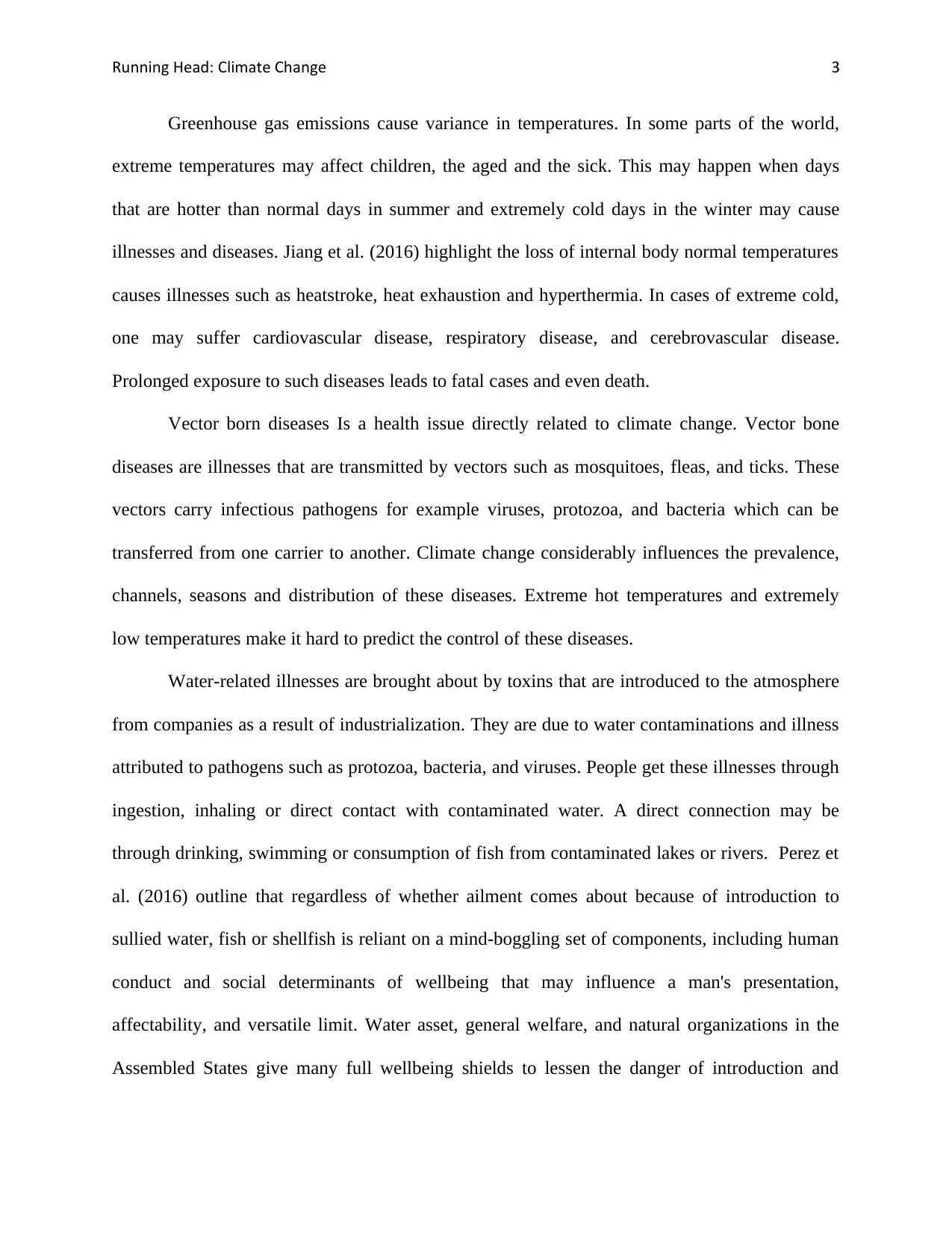
Running Head: Climate Change 3
Greenhouse gas emissions cause variance in temperatures. In some parts of the world,
extreme temperatures may affect children, the aged and the sick. This may happen when days
that are hotter than normal days in summer and extremely cold days in the winter may cause
illnesses and diseases. Jiang et al. (2016) highlight the loss of internal body normal temperatures
causes illnesses such as heatstroke, heat exhaustion and hyperthermia. In cases of extreme cold,
one may suffer cardiovascular disease, respiratory disease, and cerebrovascular disease.
Prolonged exposure to such diseases leads to fatal cases and even death.
Vector born diseases Is a health issue directly related to climate change. Vector bone
diseases are illnesses that are transmitted by vectors such as mosquitoes, fleas, and ticks. These
vectors carry infectious pathogens for example viruses, protozoa, and bacteria which can be
transferred from one carrier to another. Climate change considerably influences the prevalence,
channels, seasons and distribution of these diseases. Extreme hot temperatures and extremely
low temperatures make it hard to predict the control of these diseases.
Water-related illnesses are brought about by toxins that are introduced to the atmosphere
from companies as a result of industrialization. They are due to water contaminations and illness
attributed to pathogens such as protozoa, bacteria, and viruses. People get these illnesses through
ingestion, inhaling or direct contact with contaminated water. A direct connection may be
through drinking, swimming or consumption of fish from contaminated lakes or rivers. Perez et
al. (2016) outline that regardless of whether ailment comes about because of introduction to
sullied water, fish or shellfish is reliant on a mind-boggling set of components, including human
conduct and social determinants of wellbeing that may influence a man's presentation,
affectability, and versatile limit. Water asset, general welfare, and natural organizations in the
Assembled States give many full wellbeing shields to lessen the danger of introduction and
Greenhouse gas emissions cause variance in temperatures. In some parts of the world,
extreme temperatures may affect children, the aged and the sick. This may happen when days
that are hotter than normal days in summer and extremely cold days in the winter may cause
illnesses and diseases. Jiang et al. (2016) highlight the loss of internal body normal temperatures
causes illnesses such as heatstroke, heat exhaustion and hyperthermia. In cases of extreme cold,
one may suffer cardiovascular disease, respiratory disease, and cerebrovascular disease.
Prolonged exposure to such diseases leads to fatal cases and even death.
Vector born diseases Is a health issue directly related to climate change. Vector bone
diseases are illnesses that are transmitted by vectors such as mosquitoes, fleas, and ticks. These
vectors carry infectious pathogens for example viruses, protozoa, and bacteria which can be
transferred from one carrier to another. Climate change considerably influences the prevalence,
channels, seasons and distribution of these diseases. Extreme hot temperatures and extremely
low temperatures make it hard to predict the control of these diseases.
Water-related illnesses are brought about by toxins that are introduced to the atmosphere
from companies as a result of industrialization. They are due to water contaminations and illness
attributed to pathogens such as protozoa, bacteria, and viruses. People get these illnesses through
ingestion, inhaling or direct contact with contaminated water. A direct connection may be
through drinking, swimming or consumption of fish from contaminated lakes or rivers. Perez et
al. (2016) outline that regardless of whether ailment comes about because of introduction to
sullied water, fish or shellfish is reliant on a mind-boggling set of components, including human
conduct and social determinants of wellbeing that may influence a man's presentation,
affectability, and versatile limit. Water asset, general welfare, and natural organizations in the
Assembled States give many full wellbeing shields to lessen the danger of introduction and
⊘ This is a preview!⊘
Do you want full access?
Subscribe today to unlock all pages.

Trusted by 1+ million students worldwide
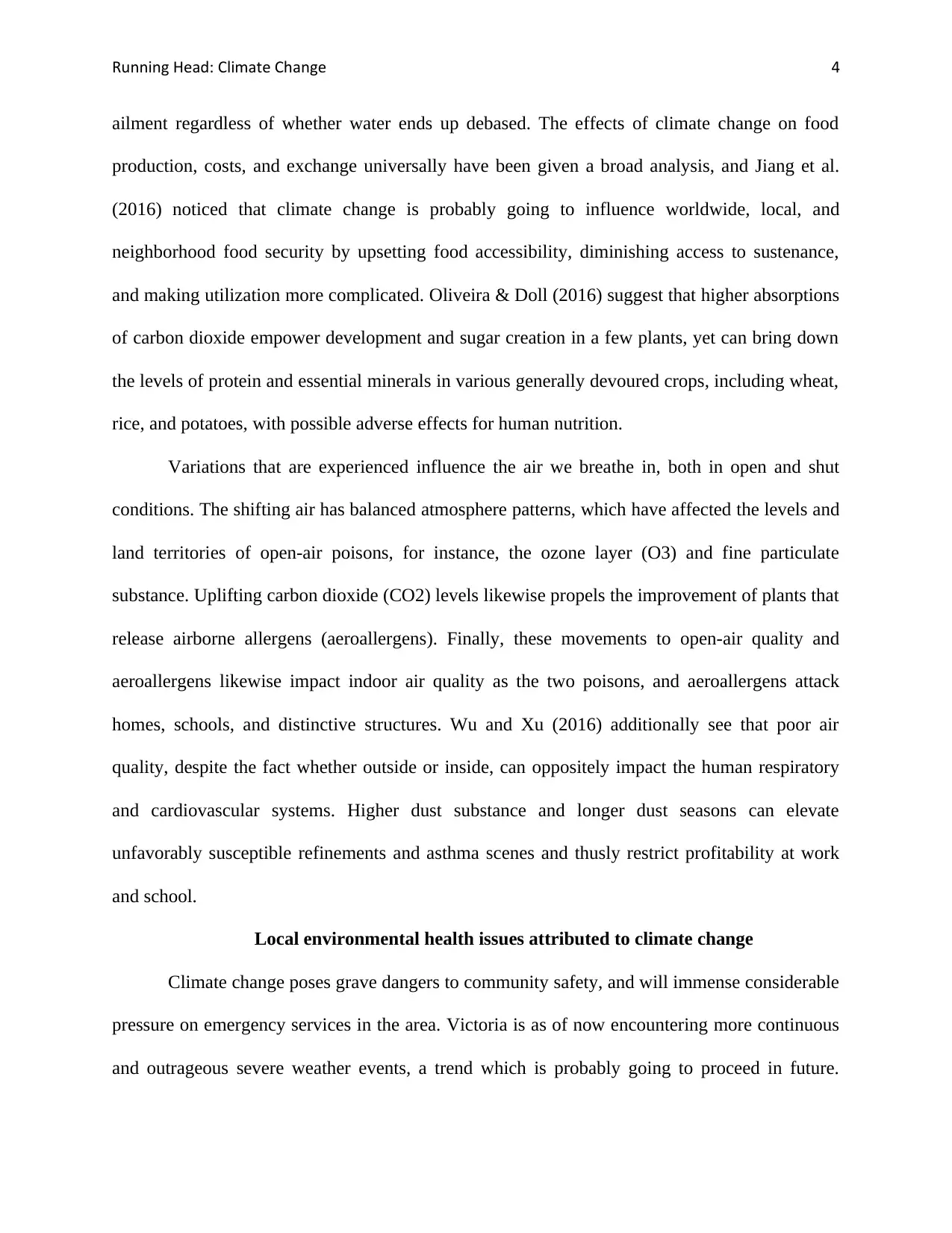
Running Head: Climate Change 4
ailment regardless of whether water ends up debased. The effects of climate change on food
production, costs, and exchange universally have been given a broad analysis, and Jiang et al.
(2016) noticed that climate change is probably going to influence worldwide, local, and
neighborhood food security by upsetting food accessibility, diminishing access to sustenance,
and making utilization more complicated. Oliveira & Doll (2016) suggest that higher absorptions
of carbon dioxide empower development and sugar creation in a few plants, yet can bring down
the levels of protein and essential minerals in various generally devoured crops, including wheat,
rice, and potatoes, with possible adverse effects for human nutrition.
Variations that are experienced influence the air we breathe in, both in open and shut
conditions. The shifting air has balanced atmosphere patterns, which have affected the levels and
land territories of open-air poisons, for instance, the ozone layer (O3) and fine particulate
substance. Uplifting carbon dioxide (CO2) levels likewise propels the improvement of plants that
release airborne allergens (aeroallergens). Finally, these movements to open-air quality and
aeroallergens likewise impact indoor air quality as the two poisons, and aeroallergens attack
homes, schools, and distinctive structures. Wu and Xu (2016) additionally see that poor air
quality, despite the fact whether outside or inside, can oppositely impact the human respiratory
and cardiovascular systems. Higher dust substance and longer dust seasons can elevate
unfavorably susceptible refinements and asthma scenes and thusly restrict profitability at work
and school.
Local environmental health issues attributed to climate change
Climate change poses grave dangers to community safety, and will immense considerable
pressure on emergency services in the area. Victoria is as of now encountering more continuous
and outrageous severe weather events, a trend which is probably going to proceed in future.
ailment regardless of whether water ends up debased. The effects of climate change on food
production, costs, and exchange universally have been given a broad analysis, and Jiang et al.
(2016) noticed that climate change is probably going to influence worldwide, local, and
neighborhood food security by upsetting food accessibility, diminishing access to sustenance,
and making utilization more complicated. Oliveira & Doll (2016) suggest that higher absorptions
of carbon dioxide empower development and sugar creation in a few plants, yet can bring down
the levels of protein and essential minerals in various generally devoured crops, including wheat,
rice, and potatoes, with possible adverse effects for human nutrition.
Variations that are experienced influence the air we breathe in, both in open and shut
conditions. The shifting air has balanced atmosphere patterns, which have affected the levels and
land territories of open-air poisons, for instance, the ozone layer (O3) and fine particulate
substance. Uplifting carbon dioxide (CO2) levels likewise propels the improvement of plants that
release airborne allergens (aeroallergens). Finally, these movements to open-air quality and
aeroallergens likewise impact indoor air quality as the two poisons, and aeroallergens attack
homes, schools, and distinctive structures. Wu and Xu (2016) additionally see that poor air
quality, despite the fact whether outside or inside, can oppositely impact the human respiratory
and cardiovascular systems. Higher dust substance and longer dust seasons can elevate
unfavorably susceptible refinements and asthma scenes and thusly restrict profitability at work
and school.
Local environmental health issues attributed to climate change
Climate change poses grave dangers to community safety, and will immense considerable
pressure on emergency services in the area. Victoria is as of now encountering more continuous
and outrageous severe weather events, a trend which is probably going to proceed in future.
Paraphrase This Document
Need a fresh take? Get an instant paraphrase of this document with our AI Paraphraser
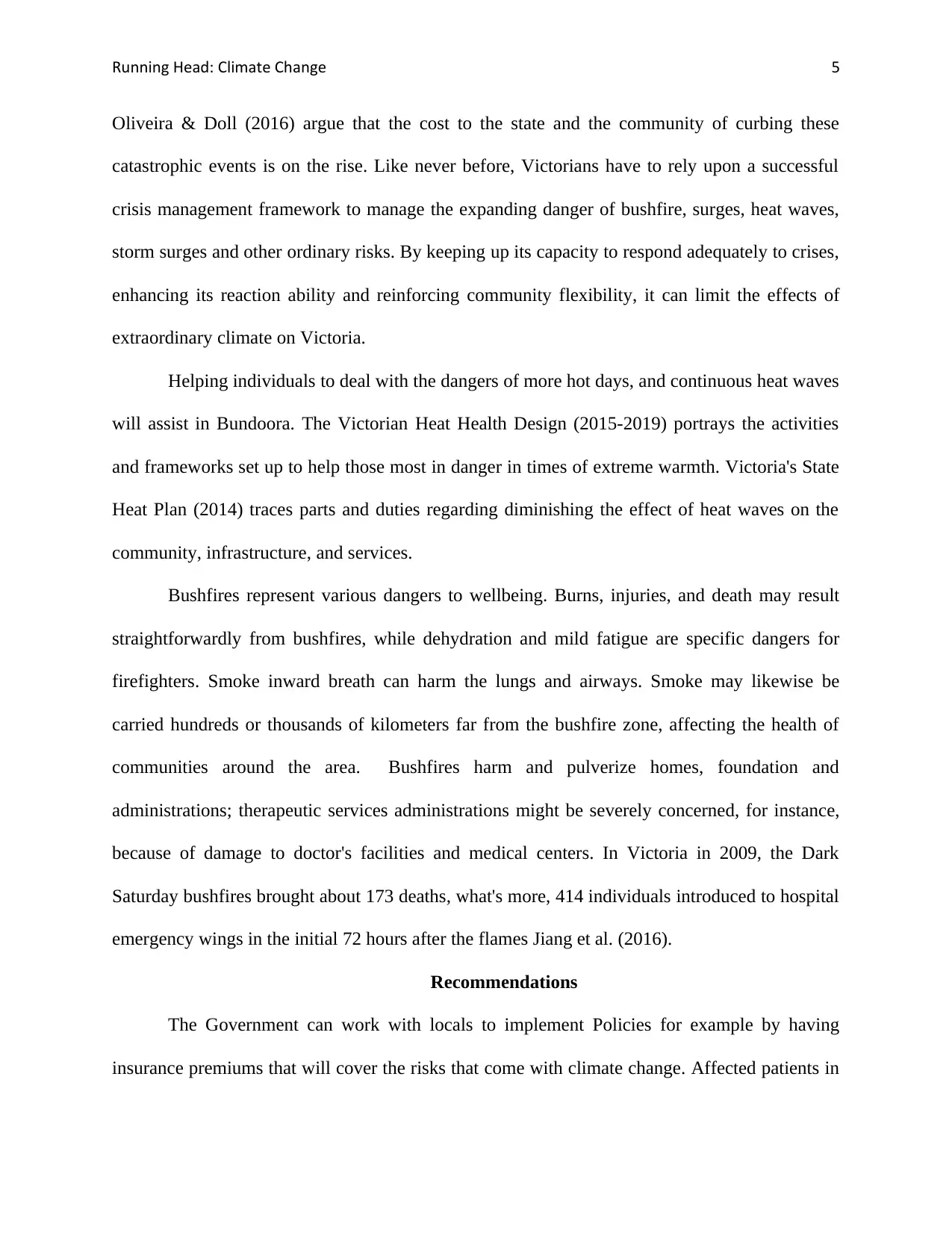
Running Head: Climate Change 5
Oliveira & Doll (2016) argue that the cost to the state and the community of curbing these
catastrophic events is on the rise. Like never before, Victorians have to rely upon a successful
crisis management framework to manage the expanding danger of bushfire, surges, heat waves,
storm surges and other ordinary risks. By keeping up its capacity to respond adequately to crises,
enhancing its reaction ability and reinforcing community flexibility, it can limit the effects of
extraordinary climate on Victoria.
Helping individuals to deal with the dangers of more hot days, and continuous heat waves
will assist in Bundoora. The Victorian Heat Health Design (2015-2019) portrays the activities
and frameworks set up to help those most in danger in times of extreme warmth. Victoria's State
Heat Plan (2014) traces parts and duties regarding diminishing the effect of heat waves on the
community, infrastructure, and services.
Bushfires represent various dangers to wellbeing. Burns, injuries, and death may result
straightforwardly from bushfires, while dehydration and mild fatigue are specific dangers for
firefighters. Smoke inward breath can harm the lungs and airways. Smoke may likewise be
carried hundreds or thousands of kilometers far from the bushfire zone, affecting the health of
communities around the area. Bushfires harm and pulverize homes, foundation and
administrations; therapeutic services administrations might be severely concerned, for instance,
because of damage to doctor's facilities and medical centers. In Victoria in 2009, the Dark
Saturday bushfires brought about 173 deaths, what's more, 414 individuals introduced to hospital
emergency wings in the initial 72 hours after the flames Jiang et al. (2016).
Recommendations
The Government can work with locals to implement Policies for example by having
insurance premiums that will cover the risks that come with climate change. Affected patients in
Oliveira & Doll (2016) argue that the cost to the state and the community of curbing these
catastrophic events is on the rise. Like never before, Victorians have to rely upon a successful
crisis management framework to manage the expanding danger of bushfire, surges, heat waves,
storm surges and other ordinary risks. By keeping up its capacity to respond adequately to crises,
enhancing its reaction ability and reinforcing community flexibility, it can limit the effects of
extraordinary climate on Victoria.
Helping individuals to deal with the dangers of more hot days, and continuous heat waves
will assist in Bundoora. The Victorian Heat Health Design (2015-2019) portrays the activities
and frameworks set up to help those most in danger in times of extreme warmth. Victoria's State
Heat Plan (2014) traces parts and duties regarding diminishing the effect of heat waves on the
community, infrastructure, and services.
Bushfires represent various dangers to wellbeing. Burns, injuries, and death may result
straightforwardly from bushfires, while dehydration and mild fatigue are specific dangers for
firefighters. Smoke inward breath can harm the lungs and airways. Smoke may likewise be
carried hundreds or thousands of kilometers far from the bushfire zone, affecting the health of
communities around the area. Bushfires harm and pulverize homes, foundation and
administrations; therapeutic services administrations might be severely concerned, for instance,
because of damage to doctor's facilities and medical centers. In Victoria in 2009, the Dark
Saturday bushfires brought about 173 deaths, what's more, 414 individuals introduced to hospital
emergency wings in the initial 72 hours after the flames Jiang et al. (2016).
Recommendations
The Government can work with locals to implement Policies for example by having
insurance premiums that will cover the risks that come with climate change. Affected patients in
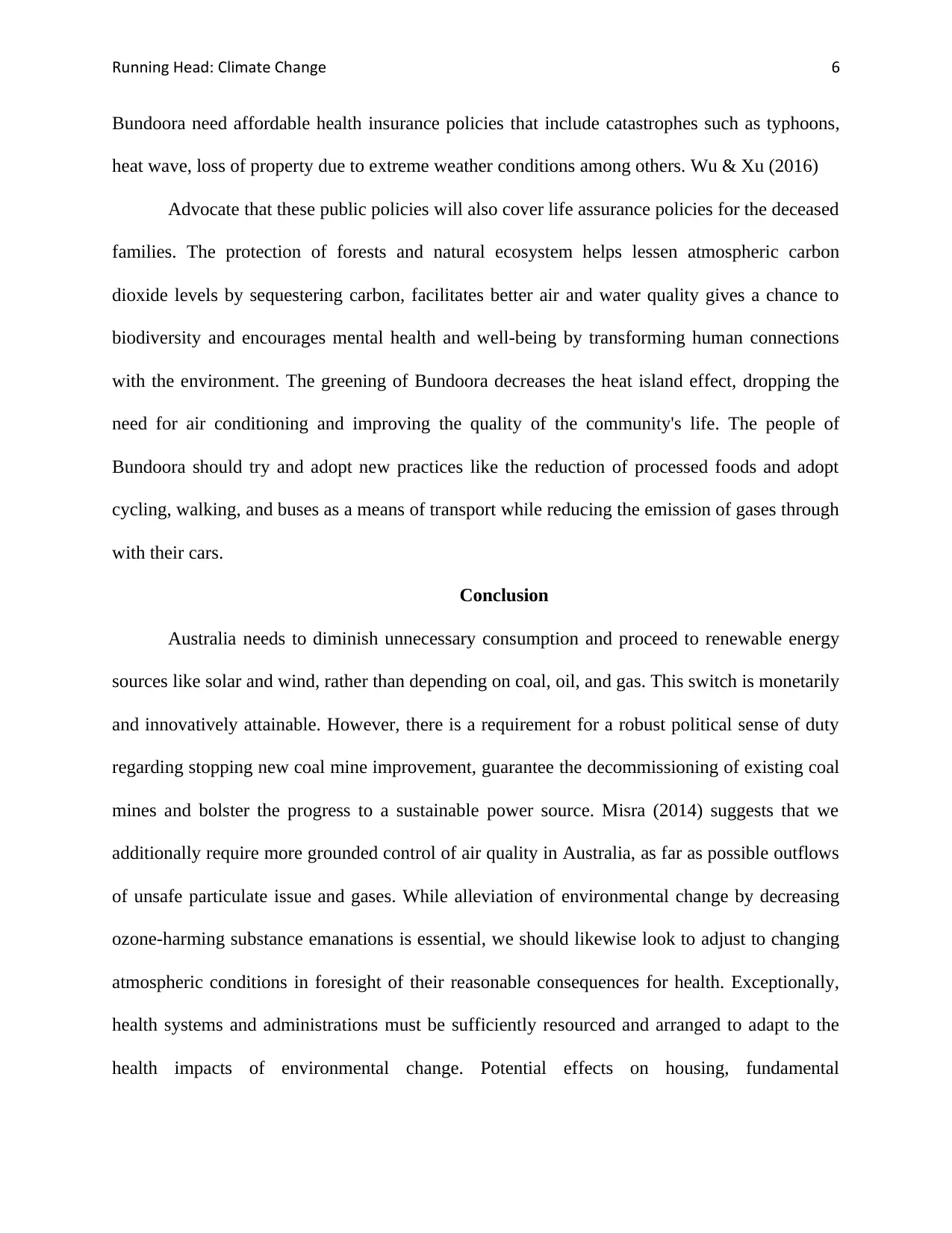
Running Head: Climate Change 6
Bundoora need affordable health insurance policies that include catastrophes such as typhoons,
heat wave, loss of property due to extreme weather conditions among others. Wu & Xu (2016)
Advocate that these public policies will also cover life assurance policies for the deceased
families. The protection of forests and natural ecosystem helps lessen atmospheric carbon
dioxide levels by sequestering carbon, facilitates better air and water quality gives a chance to
biodiversity and encourages mental health and well-being by transforming human connections
with the environment. The greening of Bundoora decreases the heat island effect, dropping the
need for air conditioning and improving the quality of the community's life. The people of
Bundoora should try and adopt new practices like the reduction of processed foods and adopt
cycling, walking, and buses as a means of transport while reducing the emission of gases through
with their cars.
Conclusion
Australia needs to diminish unnecessary consumption and proceed to renewable energy
sources like solar and wind, rather than depending on coal, oil, and gas. This switch is monetarily
and innovatively attainable. However, there is a requirement for a robust political sense of duty
regarding stopping new coal mine improvement, guarantee the decommissioning of existing coal
mines and bolster the progress to a sustainable power source. Misra (2014) suggests that we
additionally require more grounded control of air quality in Australia, as far as possible outflows
of unsafe particulate issue and gases. While alleviation of environmental change by decreasing
ozone-harming substance emanations is essential, we should likewise look to adjust to changing
atmospheric conditions in foresight of their reasonable consequences for health. Exceptionally,
health systems and administrations must be sufficiently resourced and arranged to adapt to the
health impacts of environmental change. Potential effects on housing, fundamental
Bundoora need affordable health insurance policies that include catastrophes such as typhoons,
heat wave, loss of property due to extreme weather conditions among others. Wu & Xu (2016)
Advocate that these public policies will also cover life assurance policies for the deceased
families. The protection of forests and natural ecosystem helps lessen atmospheric carbon
dioxide levels by sequestering carbon, facilitates better air and water quality gives a chance to
biodiversity and encourages mental health and well-being by transforming human connections
with the environment. The greening of Bundoora decreases the heat island effect, dropping the
need for air conditioning and improving the quality of the community's life. The people of
Bundoora should try and adopt new practices like the reduction of processed foods and adopt
cycling, walking, and buses as a means of transport while reducing the emission of gases through
with their cars.
Conclusion
Australia needs to diminish unnecessary consumption and proceed to renewable energy
sources like solar and wind, rather than depending on coal, oil, and gas. This switch is monetarily
and innovatively attainable. However, there is a requirement for a robust political sense of duty
regarding stopping new coal mine improvement, guarantee the decommissioning of existing coal
mines and bolster the progress to a sustainable power source. Misra (2014) suggests that we
additionally require more grounded control of air quality in Australia, as far as possible outflows
of unsafe particulate issue and gases. While alleviation of environmental change by decreasing
ozone-harming substance emanations is essential, we should likewise look to adjust to changing
atmospheric conditions in foresight of their reasonable consequences for health. Exceptionally,
health systems and administrations must be sufficiently resourced and arranged to adapt to the
health impacts of environmental change. Potential effects on housing, fundamental
⊘ This is a preview!⊘
Do you want full access?
Subscribe today to unlock all pages.

Trusted by 1+ million students worldwide

Running Head: Climate Change 7
administrations, community function and the economy should likewise be considered, to
guarantee that all individuals from society have the open door for good health and prosperity
administrations, community function and the economy should likewise be considered, to
guarantee that all individuals from society have the open door for good health and prosperity
Paraphrase This Document
Need a fresh take? Get an instant paraphrase of this document with our AI Paraphraser
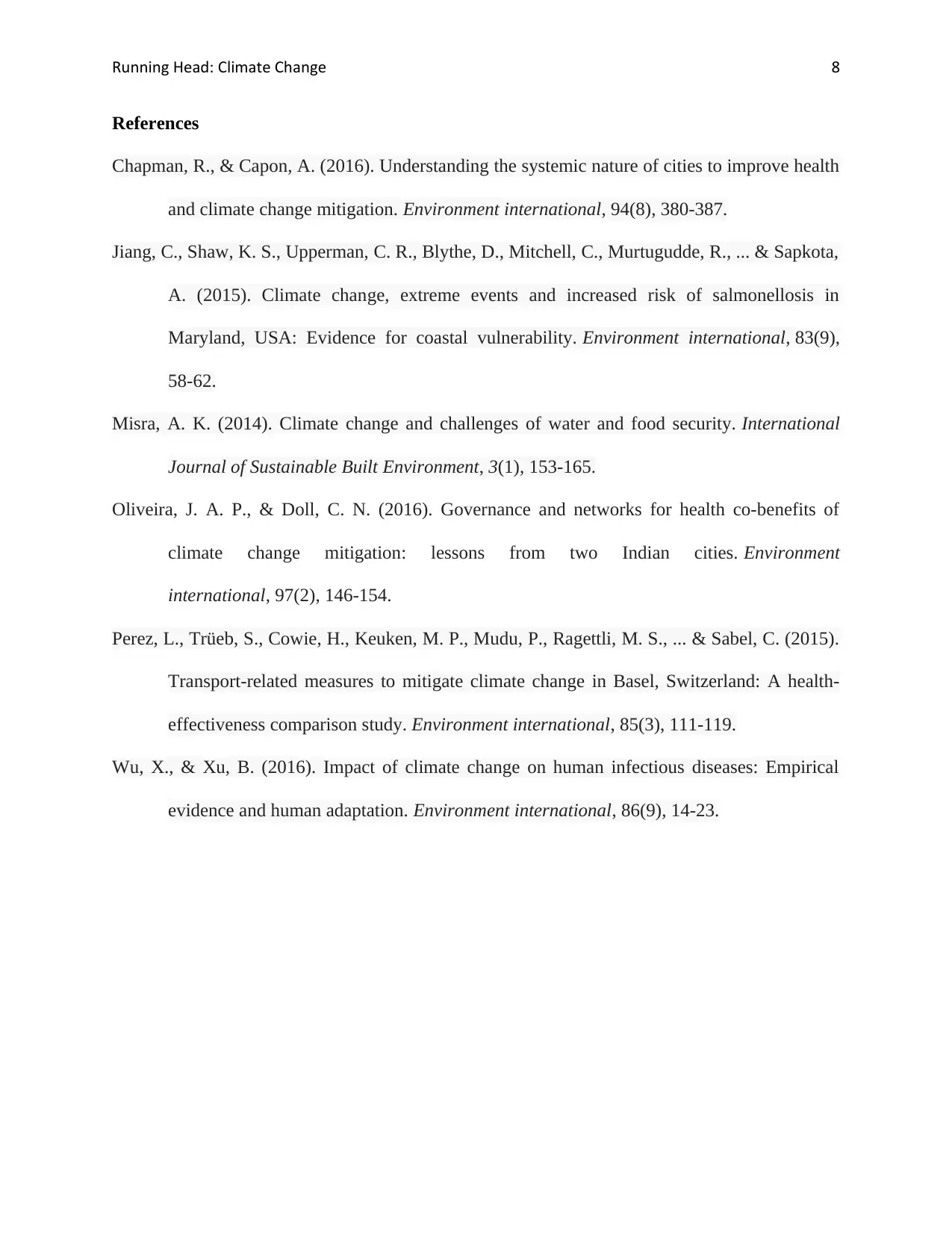
Running Head: Climate Change 8
References
Chapman, R., & Capon, A. (2016). Understanding the systemic nature of cities to improve health
and climate change mitigation. Environment international, 94(8), 380-387.
Jiang, C., Shaw, K. S., Upperman, C. R., Blythe, D., Mitchell, C., Murtugudde, R., ... & Sapkota,
A. (2015). Climate change, extreme events and increased risk of salmonellosis in
Maryland, USA: Evidence for coastal vulnerability. Environment international, 83(9),
58-62.
Misra, A. K. (2014). Climate change and challenges of water and food security. International
Journal of Sustainable Built Environment, 3(1), 153-165.
Oliveira, J. A. P., & Doll, C. N. (2016). Governance and networks for health co-benefits of
climate change mitigation: lessons from two Indian cities. Environment
international, 97(2), 146-154.
Perez, L., Trüeb, S., Cowie, H., Keuken, M. P., Mudu, P., Ragettli, M. S., ... & Sabel, C. (2015).
Transport-related measures to mitigate climate change in Basel, Switzerland: A health-
effectiveness comparison study. Environment international, 85(3), 111-119.
Wu, X., & Xu, B. (2016). Impact of climate change on human infectious diseases: Empirical
evidence and human adaptation. Environment international, 86(9), 14-23.
References
Chapman, R., & Capon, A. (2016). Understanding the systemic nature of cities to improve health
and climate change mitigation. Environment international, 94(8), 380-387.
Jiang, C., Shaw, K. S., Upperman, C. R., Blythe, D., Mitchell, C., Murtugudde, R., ... & Sapkota,
A. (2015). Climate change, extreme events and increased risk of salmonellosis in
Maryland, USA: Evidence for coastal vulnerability. Environment international, 83(9),
58-62.
Misra, A. K. (2014). Climate change and challenges of water and food security. International
Journal of Sustainable Built Environment, 3(1), 153-165.
Oliveira, J. A. P., & Doll, C. N. (2016). Governance and networks for health co-benefits of
climate change mitigation: lessons from two Indian cities. Environment
international, 97(2), 146-154.
Perez, L., Trüeb, S., Cowie, H., Keuken, M. P., Mudu, P., Ragettli, M. S., ... & Sabel, C. (2015).
Transport-related measures to mitigate climate change in Basel, Switzerland: A health-
effectiveness comparison study. Environment international, 85(3), 111-119.
Wu, X., & Xu, B. (2016). Impact of climate change on human infectious diseases: Empirical
evidence and human adaptation. Environment international, 86(9), 14-23.
1 out of 8
Related Documents
Your All-in-One AI-Powered Toolkit for Academic Success.
+13062052269
info@desklib.com
Available 24*7 on WhatsApp / Email
![[object Object]](/_next/static/media/star-bottom.7253800d.svg)
Unlock your academic potential
Copyright © 2020–2025 A2Z Services. All Rights Reserved. Developed and managed by ZUCOL.



